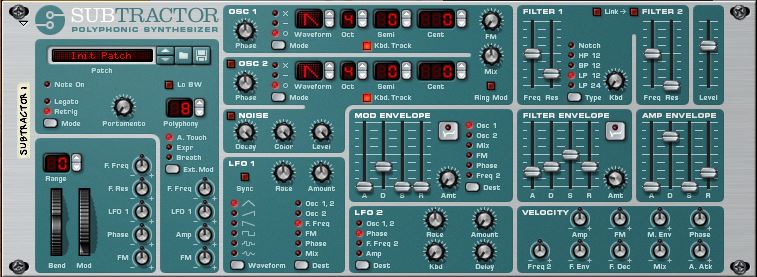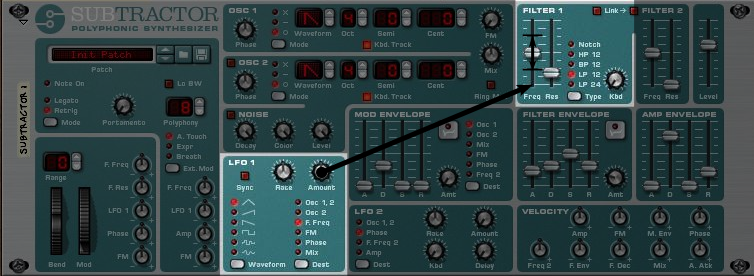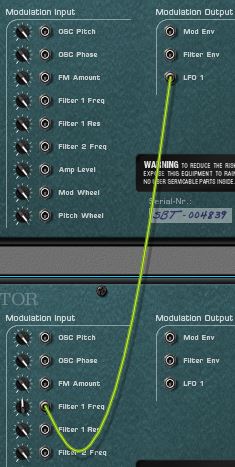Making electronic music in a DAW is a very complex thing. Most people find it really hard to learn because they approach it wrong. They want to run before they can even crawl. They want to launch into making a dance hit before they even know what an LFO is. I get that but I hate seeing the un-necessary pain.
Sadly they get frustrated and maybe even give up. This is a waste. I can teach a better way.

One of my brothers used to be a ballerina*. He is now a successful businessman. Easy to think there is nothing in common with those two vocations. In one of his first books he spoke about how as a ballerina he had to practice. This practice and hard work is what helped set him up for business success.
A fair amount of ballet practice is done at the bar – actually that is barre so get your focus back off booze. Commonly one wall of the studio has a mirror. This is to help the dancer see the shape he is making. As the dancer sees the shapes he is making, his brain learns to associate his body being in this position with that shape and files a pattern memory. A practiced dancer can be asked to do an arabesque into a plies and he does it without thinking. It is the practice that puts those positions into memory to be called on-demand.
My Spine Is The Bassline
“No guts, no blood, no brains at all”. Yay for Shreikback. If you don’t put in the work then you won’t turn out smart at all. Practice is one of my catchwords. From practice comes ability**.
In any activity there is a baseline and from that all the intricate bits come. In ballet it is barre work and learning those basic positions. In music it is notes, timing, phrases and harmonies. In synthesis it is oscillators, filters and envelopes. In mixing it is signal-flow, levels and balance.
If you go straight to the Mastering stage without using good notes, timing, phrasing and harmonies or even a decent mix then you are going to face-plant in exactly the same way I would if I tried to dance the lead in Swan Lake.
Move It On Up
A good synthesist can see the architecture of the sound he is making. A good engineer can see the bridge she is designing. By “see” I mean in-the-head. Nothing can be made without first seeing it in your head. If you aren’t used to using imagination you may need to build that muscle a bit.
Novice synthesists often ask why they can’t see all the movements of the knobs happening in real time – it feels like it would make their lives easier. If this were to happen the knobs would be whizzing around all over the place. Sounds like fun but it would also make it impossible to know the baseline state of the patch. If you don’t know the baseline of the patch you can’t make useful decisions.
You can however have exactly what you want if you can see those movements in your head.
With Closed Eyes
Let me help you learn to see using a synthesizer.
I want you to see in you mind what is happening. Once you develop the habit of being able to see what is happening then you will do far better. Initially it may seem odd, confusing, dumb… Don’t give in. Keep going, over and over, till you can see the actions happening in your head. Mimic moving the knobs if you must but the aim is to see this solely and completely in your head. The more you practice the easier it gets.
Tip: learning will come easier (and faster) if you press and hold one note till the envelopes finish. Use the same note over and over so the only changes you hear are those made by the knobs. Reduce the clutter to help your brain focus on what you want it to learn.
I have made a simple synth sound. Here is the whole patch (use any synth and pop the controls in the same positions):

I, and any experienced synthesist, can see this image and have a pretty good idea of how it will sound: Brassy. Amazed? Look at it this way:
Focus only on one part at a time. The Oscillator routes sound through the Filter to the Amplifier Envelope. The Amp Env controls the volume of sound over time:

The sound starts at no level (like fully quiet dude), rises to full volume (as set by the Master Volume Level) and then falls to nothing. The time it takes to go from one point to another is set by the sliders. In this case Attack is instant and Decay about 6 seconds over which the sound fades out. If I release the note whilst the Decay section is still being traveled then it immediately swaps to Release and drops to silence in about half a second. Play that so it makes sense to you.
That doesn’t make for a very exciting sound, we need more movement. We will do that by changing timbre over time. A subtractive Filter does this by changing the balance (respective volumes) of frequencies in the sound. The Filter Envelope allows us to change that balance over time:

We see the Envelope rise to full level in about a quarter of a second, the level then falls to the Sustain amount and will stay there till the note is released, when it will fall back to zero. That is the Attack, Decay, Sustain and Release or ADSR. See in your mind how that happens over time as per the arrow. Take your time as it will save you time later.
We decide how much of that modulation (movement) we want to send to the Filter Cutoff by setting the Amount knob to 25%:

The Env is uni-polar so it goes in one direction, which is usually upwards. See in your mind how the value of the Filter Cutoff rises and falls by a quarter of its range over time as the key is pressed. The straight arrow shows you how modulation is routed from the Filter Env to the Filter. The wiggly arrow shows you the Modulation value over time: Filter Cutoff starts at 50%, rising quickly to 75% (A), falling to 62.5% (D) whilst the note is held (S), then dropping back to 50% (R) when note is released.
Play that over and over till you can see it in your head. Play that over and over till you know exactly what is happening and why. Make some changes and play each one of those over and over till you can see what is happening and why. Make those images nice and clear in your mind. When you find you just know it then you can move on. Once you have a few of those images on-board you will find the next images come quicker.
Let’s say we wanted more movement in the Filter Cutoff (don’t blame me when this starts to sound pretty awful). The next option we have is to use a Low Frequency Oscillator. This is essentially the same as the audio Osc, just a lot slower, for Vibrato, Tremolo and other synthy effects.

Here I have my LFO using a smooth Triangle (up/down) shape and outputting half of its range by the Amount knob:

LFOs are usually bi-polar which means they rise above the starting point and then cross and fall below. See how that range which is 50% distributes itself half above and half below the Filter Cutoff value. Use your imagination to move the Filter slider to 25% and see how the LFO range is now 0-50%.
Of course with modulation coming from the Env as well, you have that Filter Cutoff dancing to two masters. Use your growing imagination to see how that LFO range moves up by the 25% sent by Filter Env then falls again to Sustain and Release values. Stick with it.
Control, ooh ooh. Now I’ve got a lot, ooh

Getting good? Great then lets show you how simple Control Voltages (CV) are. Don’t freak. CVs are exactly what we just did only the Source (LFO, Env etc.) are on one unit and the Destination are on another. The cool little wire carries the mod values from one unit to another. Get a few and they look like a spray string battle at a 10 year old’s birthday party (or how your brain feels) but don’t let that get the better of you.
Remember you have the winner’s trick. You can see everything that is going on. Bit by bit at first and then more and more over time. More, only because the more you practice seeing, the faster you get at it. Also that practice fills your brain with lots of patterns of things it has seen. When you open a complex patch you can work it out really fast because your brain matches what it sees to all the patterns you already have on-board.
Look at the pic on the right. You have a CV signal coming from a synth’s LFO and going to the Filter of another. The modulation level is 50%. Sound familiar?
If you practiced the step above, you would immediately be seeing the LFO to Filt pattern in your head. If you don’t see that then please go back and practice this again till you do.
Wax on, wax off.
– – –
*I am fully aware that ballerina isn’t the correct gender term but saying it this way amuses me. He is my brother after all.
**If you read that article they try to say that the Sex Pistols were proof that lack of ability or practice has nothing to do with success. Maybe Sid was unable to play bass (unsure about that one as some say he was at least passable – till the horse ate him at least) but the Pistols practiced heaps. They had band practice and they clearly practiced being Punks – no-none sneers that well without practice. Practice was a big part of their success. It is just that their Art was different from the virtuosity of say Steely Dan or The Eagles.
